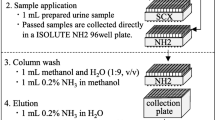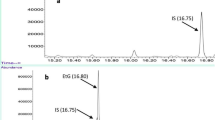Abstract
We present a series of forensic cases measuring concentrations in hair of γ-hydroxybutyric acid (GHB) and its glucuronide. The compounds were extracted from hair by incubation for 1.5 h in a 25:25:50 (v/v/v) mixture of methanol/acetonitrile/2 mM ammonium formate (8 % acetonitrile, pH 5.3). The compounds were determined by ultra-performance liquid chromatography–tandem mass spectrometry (UPLC–MS/MS). The limits of quantitation (LOQ) were 0.32 and 0.48 ng/mg hair for GHB and its glucuronide, respectively, and linearity up to 50 ng/mg. Extraction recoveries were 62–92 % for the analytes, and the accuracy was 90–108 %. Precision values expressed as relative standard deviations (%) obtained from daily controls were 9.1–11.3 % for GHB and 12.2–17.9 % for GHB glucuronide. Endogenous levels were up to 1.0 ng/mg for GHB and 1.2 ng/mg for GHB glucuronide in control subjects. In two GHB abusers, GHB was highly elevated (461–591 ng/mg), whereas GHB glucuronide was only slightly elevated in one of the subjects (1.7–3.1 ng/mg) and below the LOQ in the other. Thus, GHB glucuronide is not incorporated in hair in any appreciable amounts in GHB abusers and does not contribute diagnostically with regard to detection of exogenous exposure. To our knowledge, this is the first report to present GHB glucuronide in human hair.




Similar content being viewed by others
References
Paul R, Tsanaclis L, Kingston R, Berry A, Guwy A (2011) Simultaneous determination of GHB and EtG in hair using GCMS/MS. Drug Test Anal 3:201–205
Kintz P, Cirimele V, Jamey C, Ludes B (2003) Testing for GHB in hair by GC/MS/MS after a single exposure. Application to document sexual assault. J Forensic Sci 48:195–200
Rossi R, Lancia M, Gambelunghe C, Oliva A, Fucci N (2009) Identification of GHB and morphine in hair in a case of drug-facilitated sexual assault. Forensic Sci Int 186:e9–e11
Stout PA, Simons KD, Kerrigan S (2010) Quantitative analysis of gamma-hydroxybutyrate at endogenous concentrations in hair using liquid chromatography tandem mass spectrometry. J Forensic Sci 55:531–537
Kintz P, Goullé JP, Cirimele V, Ludess B (2001) Window of detection of γ-hydroxybutyrate in blood and saliva. Clin Chem 47:2033–2034
Verstraete AG (2004) Detection times of drugs of abuse in blood, urine, and oral fluid. Ther Drug Monit 26:200–205
Goullé JP, Chèze M, Pépin G (2003) Determination of endogenous levels of GHB in human hair. Are there possibilities for the identification of GHB administration through hair analysis in cases of drug-facilitated sexual assault? J Anal Toxicol 27:574–580
Jagerdeo E, Montgomery MA, LeBeau MA (2015) An improved method for the analysis of GHB in human hair by liquid chromatography tandem mass spectrometry. J Anal Toxicol 39:83–88
Hari Y, König S, Schröck A, Coro P, Auwärter V, Thierauf A, Weinmann W (2013) LC-MS/MS of GHB in head hair and beard. Toxichem Krimtech 80:224–227
Bertol E, Mari F, Vaiano F, Romano G, Zaami S, Baglìo G, Busardò FP (2015) Determination of GHB in human hair by HPLC-MS/MS: development and validation of a method and application to a study group and three possible single exposure cases. Drug Test Anal 7:376–384
Kintz P, Villain M, Pélissier AL, Cirimele V, Leonetti G (2005) Unusually high concentrations in a fatal GHB case. J Anal Toxicol 29:582–585
Kalasinsky KS, Dixon MM, Schmunk GA, Kish SJ (2001) Blood, brain, and hair GHB concentrations following fatal ingestion. J Forensic Sci 46:728–730
Petersen IN, Kristensen JL, Tortzen C, Breindahl T, Pedersen DS (2013) Synthesis and stability study of a new major metabolite of gamma-hydroxybutyric acid. Beilstein J Org Chem 9:641–646
Petersen IN, Tortzen C, Kristensen JL, Pedersen DS, Breindahl T (2013) Identification of a new metabolite of GHB: gamma-hydroxybutyric acid glucuronide. J Anal Toxicol 37:291–297
Berger L, Fendrich M, Jones J, Fuhrmann D, Plate C, Lewis D (2014) Ethyl glucuronide in hair and fingernails as a long-term alcohol biomarker. Addiction 109:425–431
Crunelle CL, Cappelle D, Covaci A, van Nuijs AL, Maudens KE, Sabbe B, Dom G, Michielsen P, Yegles M, Neels H (2014) Hair ethyl glucuronide as a biomarker of alcohol consumption in alcohol-dependent patients: role of gender differences. Drug Alcohol Depend 141:163–166
Kintz P, Nicholson D (2014) Testing for ethanol markers in hair: discrepancies after simultaneous quantification of ethyl glucuronide and fatty acid ethyl esters. Forensic Sci Int 243:44–46
Kintz P, Nicholson D (2014) Interpretation of a highly positive ethyl glucuronide result together with negative fatty acid ethyl esters result in hair and negative blood results. Forensic Toxicol 32:176–179
Kim HS, Cheong JC, Lee JI, In MK (2013) Rapid and sensitive determination of propofol glucuronide in hair by liquid chromatography and tandem mass spectrometry. J Pharm Biomed Anal 85:33–39
Kim J, In S, Park Y, Park M, Kim E, Lee S (2013) Quantitative analysis of propofol–glucuronide in hair as a marker for propofol abuse. Anal Bioanal Chem 405:6807–6814
Nielsen MKK, Johansen SS, Dalsgaard PW, Linnet K (2010) Simultaneous screening and quantification of 52 common pharmaceuticals and drugs of abuse in hair using UPLC-TOF-MS. Forensic Sci Int 196:85–92
Nielsen MKK, Johansen SS, Linnet K (2014) Pre-analytical and analytical variation of drug determination in segmented hair using ultra-performance liquid chromatography-tandem mass spectrometry. Forensic Sci Int 234:16–21
Peters FT, Drummer OH, Musshoff F (2007) Validation of new methods. Forensic Sci Int 165:216–224
Cooper GA, Kronstrand R, Kintz P (2012) Society of hair testing guidelines for drug testing in hair. Forensic Sci Int 218:20–24
Matuszewski BK, Constanzer ML, Chavez-Eng CM (2003) Strategies for the assessment of matrix effect in quantitative bioanalytical methods based on HPLC-MS/MS. Anal Chem 75:3019–3030
Ciolino LA, Mesmer MZ, Satzger RD, Machal AC, McCauley HA, Mohrhaus AS (2001) The chemical interconversion of GHB and GBL: forensic issues and implications. J Forensic Sci 46:1315–1323
Miyaguchi H, Kakuta M, Iwata YT, Matsuda H, Tazawa H, Kimura H, Inoue H (2007) Development of a micropulverized extraction method for rapid toxicological analysis of methamphetamine in hair. J Chromatogr A 1163:43–48
Scott KS (2009) The use of hair as a toxicological tool in DFC casework. Sci Justice 49:250–253
Kintz P (2012) Value of the concept of minimal detectable dosage in human hair. Forensic Sci Int 218:28–30
Negrusz A, Moore CM, Hinkel KB, Stockham TL, Verma M, Strong MJ, Janicak PG (2001) Deposition of 7-aminoflunitrazepam and flunitrazepam in hair after a single dose of Rohypnol. J Forensic Sci 46:1143–1151
Villain M, Chèze M, Dumestre V, Ludes B, Kintz P (2004) Hair to document drug-facilitated crimes: four cases involving bromazepam. J Anal Toxicol 28:516–519
Xiang P, Sun Q, Shen B, Chen P, Liu W, Shen M (2011) Segmental hair analysis using liquid chromatography–tandem mass spectrometry after a single dose of benzodiazepines. Forensic Sci Int 204:19–26
Kintz P (2013) Issues about axial diffusion during segmental hair analysis. Ther Drug Monit 35:408–410
Pichini S, Marchei E, Martello S, Gottardi M, Pellegrini M, Svaizer F, Lotti A, Chiarotti M, Pacifici R (2015) Identification and quantification of 11-nor-Δ9-tetrahydrocannabinol-9-carboxylic acid glucuronide (THC–COOH–glu) in hair by ultra-performance liquid chromatography tandem mass spectrometry as a potential hair biomarker of cannabis use. Forensic Sci Int 249:47–51
Castaneto MS, Wohlfarth A, Pang S, Zhu M, Scheidweiler KB, Kronstrand R, Huestis MA (2015) Identification of AB-FUBINACA metabolites in human hepatocytes and urine using high-resolution mass spectrometry. Forensic Toxicol 33:295–310
United Nations Office on Drugs and Crime (2011) Guidelines for the forensic analysis of drugs facilitating sexual assault and other criminal acts. http://www.unodc.org/documents/scientific/forensic_analys_of_drugs_facilitating_sexual_assault_and_other_criminal_acts.pdf. Accessed 1 July 2015
Acknowledgments
We appreciate Daniel Sejer Pedersen from Department of Drug Design and Pharmacology, Faculty of Health and Medical Sciences, University of Copenhagen, Copenhagen for providing reference standards of GHB glucuronide and its deuterium-labeled internal standard (GHB-d 4 glucuronide). We also thank the China Scholarship Council for providing financial support under the State Scholarship.
Author information
Authors and Affiliations
Corresponding author
Ethics declarations
Conflict of interest
There are no financial or other relations that could lead to a conflict of interest.
Ethical approval
Informed consent was obtained from all healthy individuals included in the study, who supplied small strands of scalp hair for use as control materials.
Rights and permissions
About this article
Cite this article
Wang, X., Linnet, K. & Johansen, S.S. Development of a UPLC–MS/MS method for determining γ-hydroxybutyric acid (GHB) and GHB glucuronide concentrations in hair and application to forensic cases. Forensic Toxicol 34, 51–60 (2016). https://doi.org/10.1007/s11419-015-0285-6
Received:
Accepted:
Published:
Issue Date:
DOI: https://doi.org/10.1007/s11419-015-0285-6




